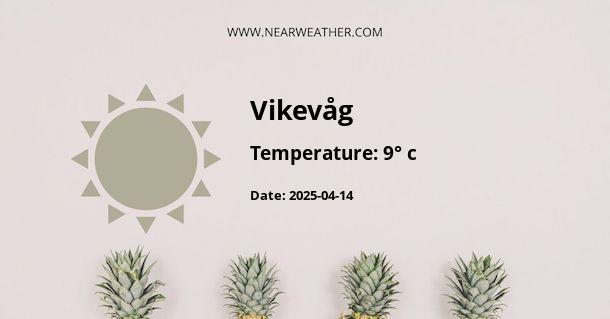Climate and Weather Overview of Vikevåg, Norway
Vikevåg is a small community located in the Rennesøy municipality on the west coast of Norway. The location enjoys a temperate maritime climate heavily influenced by the North Atlantic Current, part of the Gulf Stream system. This affords the region milder winters and cooler summers compared to areas at similar latitudes. Below is a detailed exploration of the climate and weather patterns you can expect in Vikevåg throughout the year.
Temperature Profile
The temperature in Vikevåg varies moderately throughout the year. Winters are generally cold, with temperatures rarely dropping to extreme lows, while summers are mild.
- Winter (December - February): Average temperatures range from -1 to 4 °C. The coldest months are usually January and February.
- Spring (March - May): Temperatures start to climb in March, with the average ranging from 1 to 10 °C by the end of spring.
- Summer (June - August): Average temperatures range from 12 to 18 °C, with July typically being the warmest month.
- Autumn (September - November): As fall sets in, temperatures begin to drop from an average of 10 °C in September to around 5 °C in November.
Precipitation Patterns
Rain is a prevalent feature of Vikevåg's weather, due in large part to its coastal position. The community sees significant rainfall year-round, with autumn and winter usually being the wettest seasons. Snow is also possible but tends to be more transient.
"Vikevåg, like much of coastal Norway, receives ample precipitation, making it a place where rain gear is a must-have at virtually any time of year."
Monthly Rainfall Averages
| Month | Rainfall (mm) | Rainfall (inches) |
|---|---|---|
| January | 150 | 5.9 |
| February | 112 | 4.4 |
| March | 140 | 5.5 |
| April | 106 | 4.2 |
| May | 106 | 4.2 |
| June | 132 | 5.2 |
| July | 140 | 5.5 |
| August | 190 | 7.5 |
| September | 250 | 9.8 |
| October | 270 | 10.6 |
| November | 200 | 7.9 |
| December | 170 | 6.7 |
Wind Patterns and Sunlight
The wind patterns in Vikevåg tend to fluctuate as the region experiences passing weather systems. Coastal winds can be brisk, especially during autumn and winter months. Despite this, the average wind speed is around 13 to 15 km/h throughout the year.
Daylight hours vary significantly throughout the year due to Vikevåg's northern latitude. During the summer solstice, daylight can extend to almost 20 hours, while the winter solstice can see less than 6 hours of daylight.
Average Sunlight Hours Per Day
| Month | Daylight Hours |
|---|---|
| January | 6 |
| February | 8 |
| March | 11 |
| April | 14 |
| May | 17 |
| June | 19 |
| July | 18 |
| August | 16 |
| September | 12 |
| October | 9 |
| November | 7 |
| December | 5 |
Marine Influences
The proximity of Vikevåg to the sea moderates the temperature swings and provides a marine influence apparent in the local weather. The North Atlantic Current warms the coastal waters, which helps to keep the winters relatively mild compared to the inland areas at the same latitude. This maritime effect also leads to a significant amount of fog and humidity, particularly visible during the transitional seasons of spring and autumn.
Sea Temperature Influence
The sea temperature around Vikevåg's coast typically ranges from 6 °C in the winter to about 14 °C during the summer months. This temperature range affects the coastal climate, usually resulting in a reduced range of daily temperature variation.
Effects of Topography
Vikevåg's weather can be influenced by the local topography. The region is characterized by rolling hills and rugged terrain, which can channel wind patterns and influence local precipitation. Elevation changes can also result in temperature variations within short distances, especially in terms of frost and snowfall during winter months.
Weather Extremes and Records
While Vikevåg's climate tends to be moderate, weather extremes do occur. The highest recorded temperature in the area is approximately 33 °C, which happened during a heatwave that affected much of Scandinavia. On the opposite end of the spectrum, temperatures have dropped to around -10 °C during cold snaps, though such extremes are relatively rare due to the maritime influence.
Record Precipitation Events
Heavy rainfalls and storms can lead to rapid increases in precipitation. It is not uncommon for Vikevåg to experience intense weather systems arriving from the Atlantic, which can deliver substantial rainfall in a short period, occasionally leading to localized flooding.
Climate Change Considerations
In the face of global climate change, Vikevåg, like many parts of the world, is observing shifts in weather patterns. There is notable concern regarding the increase in extreme weather events, including stronger storms, higher precipitation rates, and changes in seasonal temperature averages. Studies suggest a continuation of the warming trend, which could lead to less snowfall and more rainfall in the winters, as well as potentially warmer summers.
In conclusion, Vikevåg's climate is defined by its maritime influences, moderate temperature fluctuations, and ample rainfall. Planning a visit or activity in the area requires a solid understanding of these weather patterns and seasonal variations. With changes in global climate patterns, ongoing monitoring and research will be essential to understand the evolving climate characteristics of this coastal Norwegian community.
A - Vikevåg's Latitude is 59.097580 & Longitude is 5.696940.
A - Weather in Vikevåg is 9° today.
A - Climate Conditions in Vikevåg shows clear sky today.
A - Humidity in Vikevåg is 55% today.
A - Wind speed in Vikevåg is 11.27 km/h, flowing at 155° wind direction. today.
